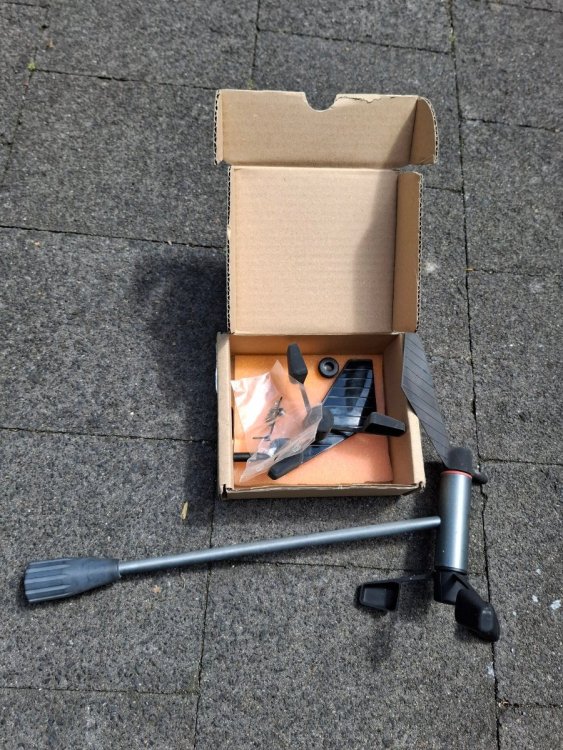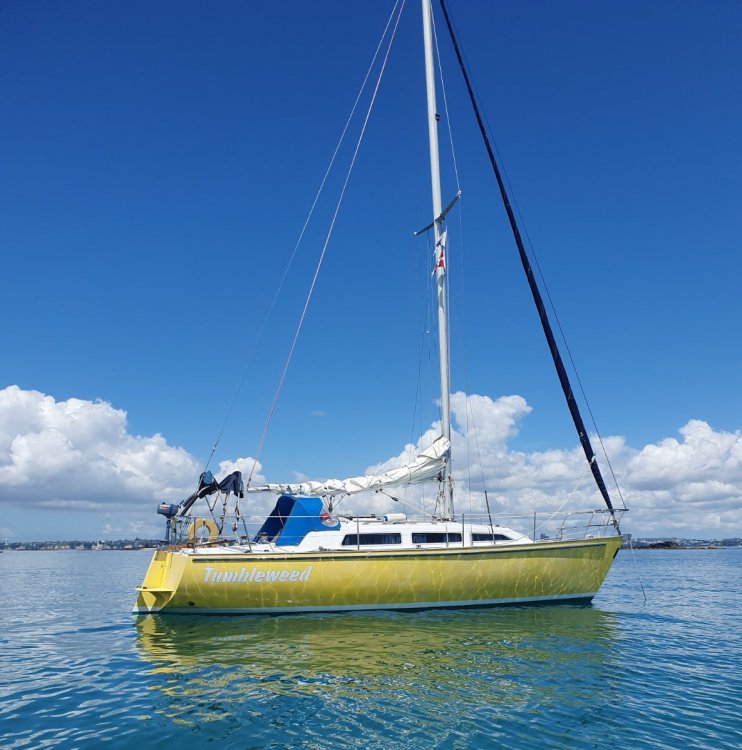
alibaba
-
Content Count
258 -
Joined
-
Last visited
-
Days Won
9
Content Type
Profiles
Media Demo
Forums
Gallery
Calendar
Store
Posts posted by alibaba
-
-
Yes, I know, here we are again. I've been in touch with the Altex rep because for the first time in 15 years I'm having problems with Altec No5.
I got more growth and barnacles than ever, plus a few new greeblies.. The rep told me that they had not changed the formula, but were experimenting with new stuff as they acknowledge that the environment has changed.
I see that Burnsco is promoting an AF I haven't seen before - SeaHAwk AF33, more expensive [ of course!].
I haven't managed to find out much about it - has anyone tried it, used it, seen any reports on it?
-
Pine Harbour management a bit deaf to the problem... gosh, who owns Pine Harbour? I wonder
-
In my experience, not long enough. I've had three different Maxwell winches over the years, and had to replace this pressure fitting regularly. I think it's made from the wrong material, it is far too brittle.
I've got to the stage where I always carry a spare, and the manufacturers don't seem to care
-
 1
1
-
-
I don't know how many of us would take on the responsibility of helming a large unknown yacht, without at least two crew, especially not knowing the condition
of the engine, sails, safety gear, and seaworthiness of the hull. If this had happened close to a harbour, I guess it would have been possible to call the local harbourmaster
and get it towed in, but Ahipara is an exposed coast, many miles from anywhere.
I am disappointed that the police however, did not at least offer to contact a salvage operator to get it towed to a harbour of owner;s choice.
-
 2
2
-
-
Thanks Carpe Diem, I can understand the idea to prevent back siphoning of water, but there is a bloody big swan neck between the exhaust muffler and the exit to the rear of the boat. That's the usual arrangement I've known. That would prevent any possibility of back siphoning I think, as apart from the height of it, the volume of the piping and the muffler must be at least 5liters. Do you think I would need both swan necks?
-
I've recently changed boats [downsized to fit my wallet!], and the new boat has something I've never seen before. It appears to have a
plastic swan neck and relief valve in the piping between the raw water pump [impeller] and the heat exchanger. The engine is a three cylinder
Nanni.
I can't see what it's there for, but before I remove it and simplify the system, does anyone else have any ideas?
-
Yep- I was not looking forward to buying a new 2HP outboard for my dinghy when I changed boats.
So - I spent around 250 on a little electric trolling motor , and a cheap 40AH ordinary 12volt battery.
I then made up some solar power leads on the battery and put it inside a strong plastic dry bag to waterproof
it. Now, no more balancing on the transom with a heavy outboard trying to put it on the dinghy, the trolling
motor weighs under 5KG, so it's one hand to carry the motor and one hand for me.
when in the dinghy, I plug the OB into the battery, and press the button.
so far so good, I think I'll get up to 60 minutes before recharge, I can recharge off my solar panel
Not to say, that I won't come across SOME snags, but so far so good.
-
I have refurbished one of these many years ago, and instructions are on the web - in colour!
ST50-Wind-Transducer-Repair.pdf
Cricalix.Net
https://www.cricalix.net › uploads › 2021/07 › S...
PDF
4 Jun 2018 — Rebuild Procedure for a RayMarine (Autohelm) ST-50/Early ST-60 Wind Transducer. Author: Richard Stidger, June 4, 2018 ... sensors for the ST-50 ...
9 pages
the mini bearings are the same as used in some fishing reels, and I got mine from a supplier in Onewa road,if he is still there. Slanty, I have a copy for you when you pick it up.
-
Thanks - slanty, it's yours
-
Raymarine, and the plug is male- 5pin. I think off a RAymarine i50 system
-
 1
1
-
-
I have a wind transducer and with spare vanes as seen in photo. It spins OK, but I think it still needs a set
of new bearings. There's apparently a set of instructions on the web, for refurbishing,and the mini bearings can be obtained.
I've sold the boat I was keeping these for so no further use.
Make me an offer and its yours.
-
Just downsized to a new boat to potter around on, and it came with a Pelagic autohelm - a type I had never come across before.
It works OK, but seems at tad overpowered for a little 28 footer. It does have a remote etc, but I don't know anything about 'em.
Thought I might sell it and get a lighter unit, but it may actually be something quite good. Anyone got any comments positive and negative about these systems please?
-
GOLD!
-
Yes, I'm sure that somewhere this has all been worked out before - but... I have a small GPS in working order, but I'm getting old [ sob!] and I need a bigger screen. Any recommendations for the best android tablet to use with navionics? - and - since I hate re-inventing the wheel- what's the best way of mounting it?
-
Quite correct, AA is the agent. But then we'd have three authorities, all with their beaurocrats, and all the expenses.
Just treat vessels as vehicles.
-
There is an easy answer to the registration problem, which avoid the incredible expense of setting up a new authority with all its staffing etc. The AA already register thousands of vehicles. Just add boat registration to the AA, minimal setup cost, just a design of one new form, and we're done.
Auckland Council of course, are thick, with their registration of jetskis. They wanted that as mentioned above to have the details of the owners in case of misbehaviour, loss etc.
Why, oh why, did Auckland Council simple not say "register your jetski by getting a VHF callsign". The same information is logged with your callsign, it uniquely identifies you, and best of all, if you get into trouble, Coastguard can assist, and has your details in case of emergency.
-
Little snag to batteries shorting out in sea water. I'm pretty sure from my chemistry that the following occurs: Sea water contains salt ie chloride ions. They take up electrons for the battery and form Chlorine gas - very toxic. Not nice to be in an enclosed space with.
-
MMMM.. what are we actually talking about here - apart from supporting the electronics industry to the tune of 1000s.
Speed of vessel using wind angle, cheek sensors, and telltales = 6.2kts
Speed of vessel using all the above gear = 6.5 kts??
I guess it's great for the racers, but otherwise it would probable be more than my Lotus is worth.
Now - if someone could come up with a device to produce the most comfortable sailing angle....
-
thanks all, your info much appreciated.
-
Help/info please. I've come across a well loved Easterly 30. I've sold my boat and I am looking for a boat in which I can potter around the gulf from Kawau to Coromandel in my advancing years [ not going to say how advanced!]
How do they sail, say compared to boats of similar size eg Lotus 9.2; Davidson 28 etc.
All info gratefully received.
cheers
-
nope, but I have about three or four years worth of Practical boat owner mags, which I was going to throw out. If you want to pick up, they're yours.
-
Looking to find one which has been looked after, downsizing for pottering about
-
I don't know if they are all built the same, but on my Lotus 9.2 there are three pintles and gudgeons connecting the skeg to the rudder blade. To remove the rudder blade and get at the bearings, you actually remove the each piece of wood on the rudder blade just above the supports. It's about 50mm high, and is usually screwed or glued in there as a separate piece. Once you have removed them, the rudder can be lifted off the pintles.
-
Built 1988 - to MOT specs, maintained to a very high standard. All gear. Selling with marina berth. Reason? 80 years dammit, and the pension just won't support a boat. Would like a half share really, then I could keep sailing for while yet. See full details on TM.
Triple skin kauri, all mod cons. Will consider offers on this forum.
-
 1
1
-



.thumb.jpg.73a3baa290fa6b9d4deb4492644330fc.jpg)
This Weekend's Achievements
in MarineTalk
Posted
Trade me has also got some land rover wireless winch controls, about $60 last time I looked. They worked real well from all over the boat. Quite useful to be able to stand in your cockpit and lift the anchor from a distance in a crowded and windy anchorage. I've got past the stage where I have to go forrard to lift the anchor and then run like hell back to the controls before the wind can swing me into the adjacent boat. Winch remotes are essential I reckon if you are single handed.